13. Xiongnu and the Wusun People
http://www.dandebat.dk/eng-dan13.htm
Xiongnu
The Chinese historian Sima Qian described the Xiongnu in Chapter 110 of his "Historical Records", "Shi Ji":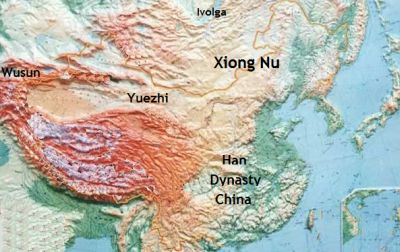 Xiongnu had lived on the eastern plains - always.
Xiongnu had lived on the eastern plains - always."From the King and downward they all ate the meat of their livestock, and clothed themselves with their skins, which were their only dress. The strong ones ate the fat and choose the best pieces, while the old and weak ate and drank, what was left. The strong and robust were held in esteem, while the old and weak were treated with contempt."
That brings our thoughts to the household troops of the ancient Danish king Rolf Krake. They sat at the table after rank; the highest ranking took the best pieces of meat and threw the bones in the head of the frail looking newcomers accompanied by rude laughter.
The "Shi Ji" tells further about Xiongnu: "Early every morning the King, whom they called Shan-ju, went outside the camp in order to worship the sun at sunrise. In the evening he worshipped the moon."
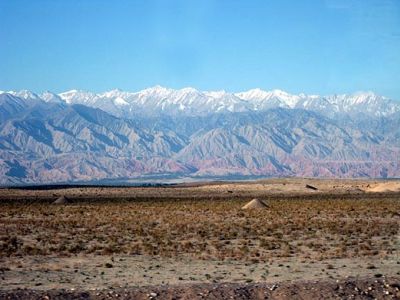 Qilian Mountains - Xiongnu had a religious relation to the Qilian Mountain range.
Qilian Mountains - Xiongnu had a religious relation to the Qilian Mountain range.Almost all the peoples of that time worshipped the Sun and the Moon in one way or another. The Chinese emperor went to special Temples for the Heaven or the Moon, asking for good year and good harvest for his people. Yuezhi worshipped the Moon and the later Sogdians worshipped their sun god, Mithra. It was the kings and the emperor's most important duty to secure the good relations to the mighty powers of Heaven.
If the gods did not live in heaven, then they at least lived up some high mountains. The Greek Gods, for example, dwelt on the mountain of Olympus. The Xiongnu people had a religious relationship to the Qilian Mountains, however we have no knowledge of any details concerning this part of their faith.
The historical museum in Xian exhibits some figures from Tang Dynasty graves. They represent Xiongnu,"the Huns", according the museum's sign. During Tang Dynasty, there were apparently still Xiongnu on the plains. We can see, how they looked like. (Tang Dynasty was from AC 626 to 907 AC).
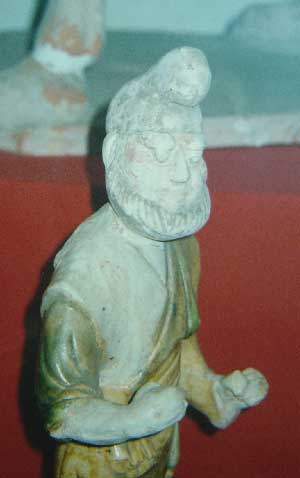
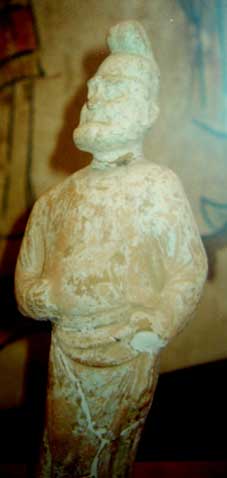
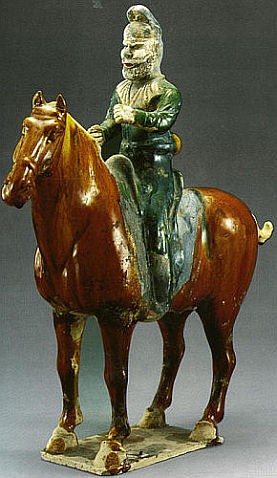 Left: Xiongnu figure from Xian History Museum 1.
Left: Xiongnu figure from Xian History Museum 1.Mid: Xiongnu figure from Xian History Museum 2.
Right: Sculpture representing mounted nomade - from Anpu and his wife's tomb in Longmen Luoyang - found 1981 - Tang dynasty.
They have large round heads, often barrel-shaped bodies, sometimes a potbelly, and most often a strong skipper beard from one ear to another. A bit of paint is left on the head on one of the figures; the hair colour is black. They are usually wearing some sort of cap, similar to the caps of traditional Danish Christmas goblins. They are "Hu" types, which means Caucasian types with sharp nose, deep eye sockets and strong beard. They are standing in somewhat challenging postures as very self-conscious people. This kind of figures was previously labelled as Western traders in China or the like, I remember, but they are really Xiongnu, says the sign behind the glas. The museum could be wrong; the Xianbei people as well played an important role in North China during the Tang Dynasty.
The reminds about Loki in the norse mythologi, he was also dark because he descended from the Jotuns. He also had a type of personality, which made it difficult for him to stay in the background.
Unfortunately, the figures are not in natural size, so they give no direct indication of their absolute size.
However in the vicinity of Xi'an is located General Huo Qubing's tomb. He was the Han Dynasty general, who defeated Xiongnu using the new cavalry on the great horses, they got from the Yuezhi in the Fergana Valley, "The horses who sweat blood", also called "The Heavenly Horses".
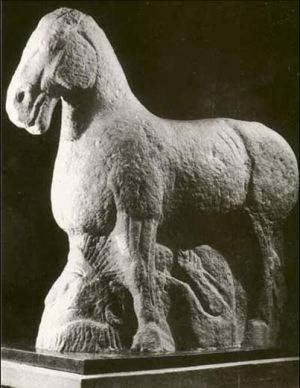
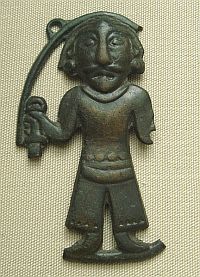 Left: One of the heavenly horses trambles on a Xioung Nu - from Huo Qubing's tomb.
Left: One of the heavenly horses trambles on a Xioung Nu - from Huo Qubing's tomb.Right: Bronze figure found in the Ordos Area, which was Xiongnu Area. Many want to make Xiongnu to a kind of Mongols - but he does not look like that.
In the general's tomb is a figure of one of the "horses, who sweat blood", who is about to trample a Xiongnu to disintegration. We see clearly the characteristic skipper beard from one ear to another. Note, how big the Xiongnu man is in relation to the horse. Even if it is an artistic exaggeration, the Chinese of those days still may have thought, that Xiongnu men were very big.
Many will make the Xiongnu into a kind of Mongols. But a bronze figure found in the Ordos area, which was Xiongnu territory, does not look Mongolian; he has big eyes, powerful beard and big nose.
The Chinese wrote, that Xiongnu (Hsiung-nu) were never very numerous. Together they were not as many as the inhabitants of a single Chinese province. "Their advantage lay in their strength," they wrote.
They were not numerous enough for a real conquest of China or even parts of the Empire. Their favourite tactic was rapid raids into Chinese territory. They robbed cattle and abducted countless, women, children and young people as slaves. They withdrew to the steppe before a proper military force could be assembled against them.
The original Chinese nations in "the warring states" period built walls and dykes at their northern borders to prevent the barbarians to access their territory, however apparently with little success. After the Qin had conquered all of China in 221 BC, they linked these local walls together and thus made, what we know as the Great Wall.
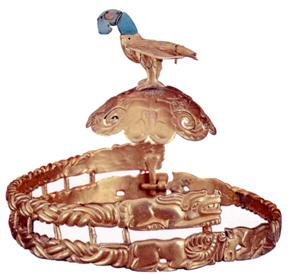
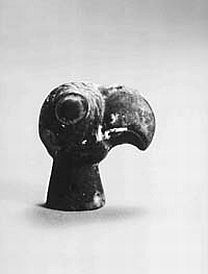 Left: Xiongnu head decoration.
Left: Xiongnu head decoration.Right: Xiongnu banner decoration - also an eagle.
Han Dynasty China was not the only nation, which suffered from the attacks of the Xiongnu. Many people in Asia were exposed to Xiongnu's aggressiveness, especially the city-states in the Tarim Basin. Xiongnu drove the Yuezhi people from their original homeland in northern Gansu.
The Jotuns were the age old enemies of the Aesirs. The god Thor was very often away from home to fight against Jotunss.
There can be no doubt, that the greatest threat to the peoples of Midgaard was the Xiongnu. They may be a possible bid for the Jotuns, or at least some of them.
The Chinese were not very analytical in their description of the surrounding peoples. Sometimes they called them all together for Qiang, other times they were all named Xianbei. They did not go very deep into how they looked like, their cultural habits and what language they spoke. During the Han Dynasty most of the Peoples on the steppe were grouped under the label Xiongnu.
It is obvious, that the Xianbei, Qiang, Di and Jin have been there all the time in one way or another; they have only been seen as a part of the Xiongnu, which was the dominant ethnic group.
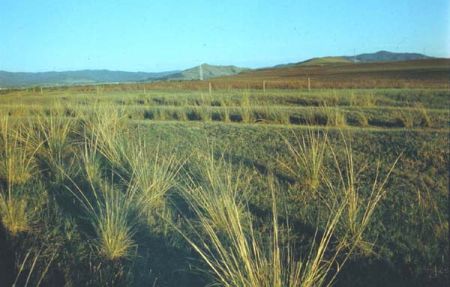 The Ivolga fortress.
The Ivolga fortress.Russian archaeologists have excavated many Xiongnu settlements in the Ulan-Ude region near Lake Baikal. Here have been Xiongnu settlements until well into the Middle Ages.
The Xiongnu fortress by Ivolga is located 16 km. from Ulan Ude by the Selanga River. It is square with dimensions of 350 x 200 m., and it has a moat all around. Within the ramparts many houses were half dug down in the surface, of which 54 have been excavated. Each house had a stone fireplace in its northeastern corner. This type of house, dug down in earth, is also well known from the time of the Danish Vikings. A large house in the centre of the fortress was the only one, which stood on the ground.
At Ivolga they buried their dead on flat terrain, they were not placed in burial mounds. Many graves were in groups. There was a central grave, with a probably high-ranking person in the middle; which was surrounded by smaller accompanying graves, which in general contained the bodies of women, children and young people.
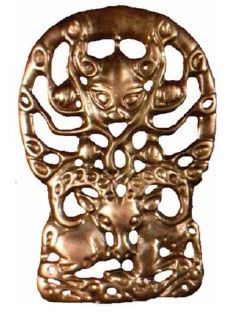 Xiongnu broche found at Ivolga.
Xiongnu broche found at Ivolga.Many of those in the accompanying graves showed signs of a violent death. It looks like that the Ivolga Xiongnu had the practice, that when a high ranking person died, all his wives, mistresses, slaves and apparently also some children had to follow him to the other world.
"Xiongnu" means literally according to the Chinese character something like "Slaves of the Peoples". However, there is no doubt, that this is not their real name, as they called themselves. It is a somewhat condescending name, which the Han Dynasty Chinese gave them, just in the same way as they gave names to many other peoples around their borders.
In "The Silk Road", edited by Susan Whitfield, Etienne de la Vaissiere explains the Xiongnu's real name.
There have been found a sogdian letter from the fourth century, which refers to the Xiongnu's looting in connection with the Jin Dynasty's collapse also in the fourth century. The letter mentions the Xiongnu with the term "Xwn", which is the sogdian spelling of the word "Hun". The author of the letter proves otherwise a first-hand knowledge of events. Therefore, he must be considered as a very reliable source.
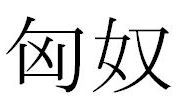 Xiongnu written with Chinese characters.
Xiongnu written with Chinese characters.The Kushan monk, Zhu Fahu from Dun Huang, translated "Tahagataguhya-sutra" from Sanskrit to Chinese in 280 AC. In this document he translated the Sanskrit word "Huna" to "Xiongnu". He did it again in 308 AC by the translation of "Lalivavistara". In a not very distant past, these "Huna" had driven away the Yuezhi people from their original land with their ancestors graves. Zhu Fahu was a Kushan and he descended directly from Yuezhi. He may not have been in doubt, as to who was these "Xiong Nu", and what was their real name. The writer of the Sogdian letter may of the same reasons also have had a clear idea of Xiongnu and their real name.
Indian sources also described the Xiongnu as "Huna". (Everything from "Silk Road" page 22).
Then it must be that the Xiongnu people became known in Europe under their real names, as they called themselves, which is "Hun".
"Wei-Shu" is the story of the Wei Dynasty. It was written about the years 437 AC - 457 AC. It says: "Earlier, Xiongnu killed the king (of Sogdiana) and took the land. "King Huni" is the third ruler in the line."
We remember Saxo's tale of King Frode and the war between the Danes and the Huns. Here he wrote: "Two years had "King Hun" devoted to preparations for his campaign against the countries around the Baltic Sea."
When you read this, it is hard not to feel, that it is too simple just to call the king of the Huns for "King Hun." It must be something, the old storytellers have added themselves, we are tempted to think.
But, as one can see, Saxo Grammaticus was very well informed. Some of the Hun kings were actually named "Huni" or perhaps "Hun".
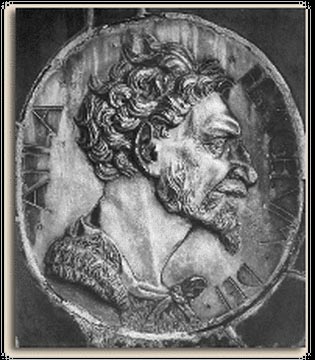 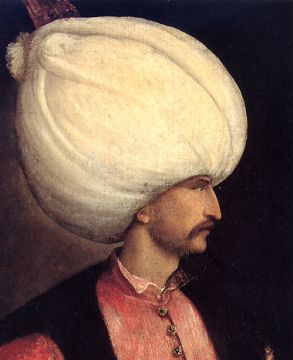 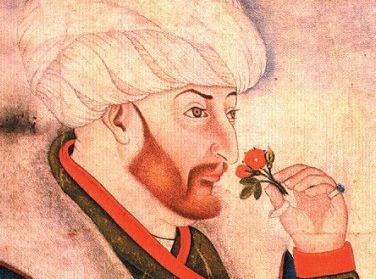 |
Mid: The Turkish Sultan Suleiman the Great.
Right: Mehmet II - the conquerer of Constantinopel.
Attila on the coin and the turkish rulers actually look like each other.
We remember Priscus' description of Attila, King of the Huns, preserved to our time by Jordanes in his "Getica sive De Origine Actibusque Gothorum (The History of the Goths): "He was short of stature with a wide chest, a large head, thin beard with grey stains, stub nose, and he showed his ancestral traits (originis suae signa restiuens). His personality was such, that he always promoted himself with high self-confidence." ("Attila" page 144)
In Priscus' own description in Greek this description does not occur, although it is very detailed.
The Hun king Attila, has beeen pictured on a contemporary European coin. He certainly does not have stub nose, but he looks actually like the turkish sultans Suleiman and Mehmet.
On Xiongnu's belt buckle ornaments, the depicted persons also seem to have rather big noses, they do not look like mongolid types.
On the Internet can be found an article that describes a genetic survey, which compares the genetic material of individuals from Mongolia's ancient past with modern European and Asian individuals. It is called the "Linzi" survey. (see link below).
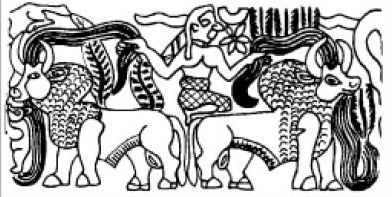 Xiongnu ornament in drawing - notice that the person in the middle has a big nose - he cannot be a mongolid type.
Xiongnu ornament in drawing - notice that the person in the middle has a big nose - he cannot be a mongolid type.Samples have been taken from a burial place at Egyen Gol in the north of Mongolia and from contemporary European and Asian individuals. The Burial ground was from about the time of the Han Dynasty (200 BC - 300 AC), which was the glorious time of the Xiongnu. Two thousand years ago the Xiongnu surely inhabited the Egyen Gol area. The Mongols had not yet migrated from Sirbiria and the concept of Turks did not yet exist.
The genetic material from Egyen Gol showed a good correlation with the genes of modern Asian peoples, especially in northern and central Asia, but a less good correlation with modern European peoples. Xiongnu genes also had many similarities with gene samples taken from a some thousand years younger definitely Turkish funeral ground, also located near Egyen Gol.
The Asian Turks have always claimed that they descended from the Xiongnu. The Linzi genetic study suggests that there is something about it.
The article also describes the genetic correlation between individuals who were buried at Linzi in the Chinese Shandong Province, and modern people in Europe and Asia. The graves at Linzi were from the period of "the Warring States" (500 BC - 221 BC).
There appeared to be a good genetic correlation between ancient Shandong and the West. The ancient Chinese in Shandong seemed to be most related to Iranians and Europeans, especially Icelanders, Finns and Turks from Turkey. The Chinese genes showed a less good correlation with many modern Asian peoples.
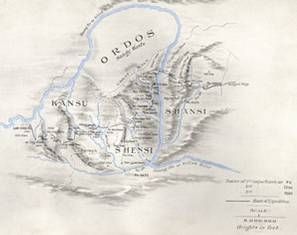 Many think that the Ordos plateau is Xiongnu's original homeland.
Many think that the Ordos plateau is Xiongnu's original homeland.The ancient populations in Shandong and in the northern part of, what today is known as Mongolia, do not appear to have been much related.
The Yellow River makes a big turn against north into Mongolia. The contained area is called Ordos. It is assumed to be the original homeland of Xiongnu, especially by Chinese archaeologists. Here many Xiongnu animal ornaments have been found .
They remind about schytian animal ornaments, but they do not have the same artistic nervous touch. The ancient Scandinavian grip animal style seems to be a more abstract development.
Below left: The viking figure, the London animal - the Skandinavian grib animal style seems to be an abstract and surrealistic development - Sct. Pauls churchyard in London.
Mid: Schythian animal ornament.
Right: Xiongnu animal ornament - full of fantasy, but it does not have the same nerveous touch as the schytians.
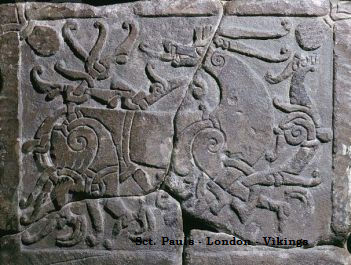
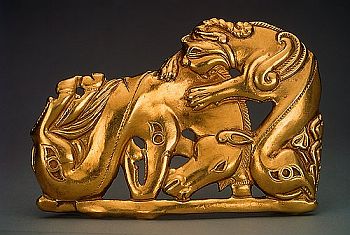
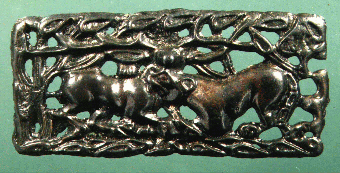
| See "Linzi" genetic survey: Reanalysis of Eurasian population history: Ancient DNA evidence of population affinities See also Xiongnu Archaeology - Silk Road Seattle Étienne de la Vaissière explains Xiongnu's real name on: Encyclopædia Iranica , edited by himself. Search for Xiongnu and choose the article "Xiongnu". See The History of Chinese Relations with the Hsiung Nu - translatet by Daniel C. Waugh. Close to all information about the fighting between Goths and Huns we have from "The History of the Goths" by Jordanes: GETICA sive De Origine Actibusque Gothorum - first half and following: GETICA sive De Origine Actibusque Gothorum - second half on vulgar latin and english. See also Priscus' report on his visit to Attila's court: Priscus at the court of Attila - Medieval Sourcebook tranlated from greek to english by J.B. Bury. |
The Wusun people
On the plains at the Ili River and the salty Lake, Issyl Kul, lived a people of Caucasian type. We don't know any of their language, but they may have been Indo-Europeans. The Chinese called them Wusun (Usun).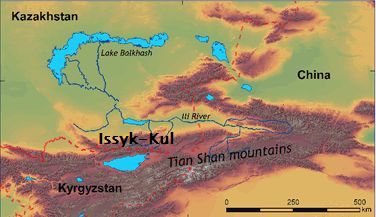 The salty lake with the Turkish name Issyl Kul.
The salty lake with the Turkish name Issyl Kul.In the ancient book "Han Shu" the scolar Yan Shigu has added a comment about Wusun's appearance: "Wusun in the western areas is the same as the "Rong" people (old name for different tribes and peoples around China). Now a days, these "Hu" people have green eyes, red beard, their appearance is like bearded monkeys, and they are originally of this kind."
Zhang Qian, travelled to the west on behalf of the Han Emperor in order to meet the Yuzhi and create an alliance against Xiongnu. He also met the Wusun and reported that: "The people have "pig heads", they are cunning as wolves and highly unreliable. They are very prone to pillaging, and they are as a nation typically violent."
Pigs have, as one knows, big noses and sometimes blue eyes, so most likely it is true, that Wusun had blue eyes.
Chinese archaeologists have informed, that Wusun was a Caucasian type of people with short skull. They cannot say anything about the colour of their eyes and hair.
Accurate, as always, Zhang Qian reported, that there were 120,000 Wusun families, and their army numbered 188,000 mounted men. The country was cold and rainy, but with extensive pastures. The mountains were covered with pine forest. Wusun raised horses. Rich men could own up to five thousand horses.
Wusun recognized Xiongnu's supremacy, but they had their own king, who bore the title kiun-mo. He named himself as Son of Heaven.
The Chinese sought to create an alliance with Wusun directed against Xiongnu, the Huns. To this end, the Chinese court in 107 BC sent a princess the long way from the imperial capital Xi'an to Wusun's cold rainy country.
The princess wrote a poem:
My family has married me away
Helpless I am, can do nothing
In a distant exotic kingdom
Married to the King of Wusun
My home is simple
The walls covered with felt and not with silk
My daily food is pork
Milk I drink to the food
I am burdened by dark thoughts
My heart is heavy with sorrow
If only I were a yellow stork
So I would fly back to my nest.
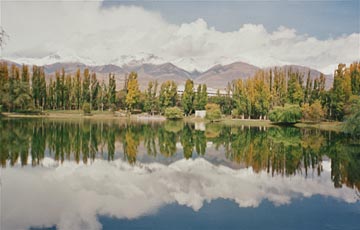 The shore of the salty Lake with the turkisk name Issyl Kul.
The shore of the salty Lake with the turkisk name Issyl Kul.The new queen was entitled kiun-di. For her pleasure a Chinese palace was built in the camp of the Wusun king. The royal residence was of the Chinese called "The Palace in the Red Valley." It was located in some distance from the salt lake.
The great traveller Zhang Qian was hold as a prisoner by Xiongnu for 10 years. There he heard the following story about Wusun:
"When your servant was a prisoner of Xiongnu, he heard, that the king of Wusun, who bore the title" Kun-mo", and that kun-mo's father was the head of a small state at Xiongnu's western border.
Xiongnu-attacked and killed his father and Kun-mo was at his birth thrown away in the wilderness, where a black bird (a raven?) Brought him meat, and a she-wolf nourished him with milk.
Shan-yu was the title of the king of Xiongnu. He considered this to be a wonder, and after he had brought up the boy, he made him a military leader, in which capacity he distinguished himself on several occasions. Shan-yu re-established his father's people, and made him a governor of the western fortified camp.
As he received tax from his people, the Kun-mo could attack the small neighbouring states with tens of thousands of arcxhers, he collected experience in warfare, and after the old Shan-yu's death, he withdrew to a distant place and refused to show up at the Xiongnu court.
Xiongnu ordered picked troops to attack him, but because they were unable to overcome him, they considered him as a spirit, to whom they did wise to keep a certain distance and not attack him seriously.
Xiongnu's Shan-yu continued to claim nominal supremacy over Kun-mo and his Wusun people."
Thus was the great traveler, Zhang Qian's report to his emperor.
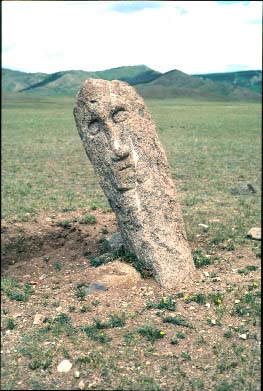
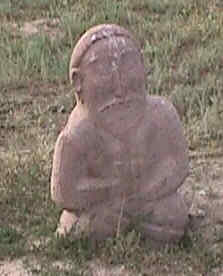 Left: Stone man on the plain at the Ili River 1.
Left: Stone man on the plain at the Ili River 1.Right: Stone man on the plain at the Ili River 2.
The Chinese princess' grandson was called something like "Ud-zyty". Already in his reign the country has been divided into smaller and bigger areas, and the camp around the Palace in the Red Valley had been abandoned forever.
No one knows what since happened to the Wusun people. In 630 AC the Khan of the Western Turks could receive the Buddhist monk, Xuanzang, on the banks of the salty lake with the turkish name "Issyl Kul".
On the plains near the Salty Lake are the stone men. They can be found many places in Central Asia. Some of them are undoubtedly sat by the Western Turks. Some of them are probably also made by those who lived there before Wusun came. It was customary at some Indo-European peoples to erect stones over brave men and create gods and ancestors in stone - a practice which the ancient Greeks had perfected.
| See the book "Nomads on the Eurasian Steppes in the Early Irom Age" all 399 pages: Nomads on the Eurasian Steppes - (pdf) See pictures and descriptions of the Scytian Guld Pectoral found in Ukraine: Perfection embodied in Gold See also: Scythian treasures, gold decorations and amazing discoveries And on another Ukranian page: Scythian material culture - Olena Fialko Institute of Archaeology, Kiev, Ukraine |
| Back to top of article |
20130210
No comments:
Post a Comment